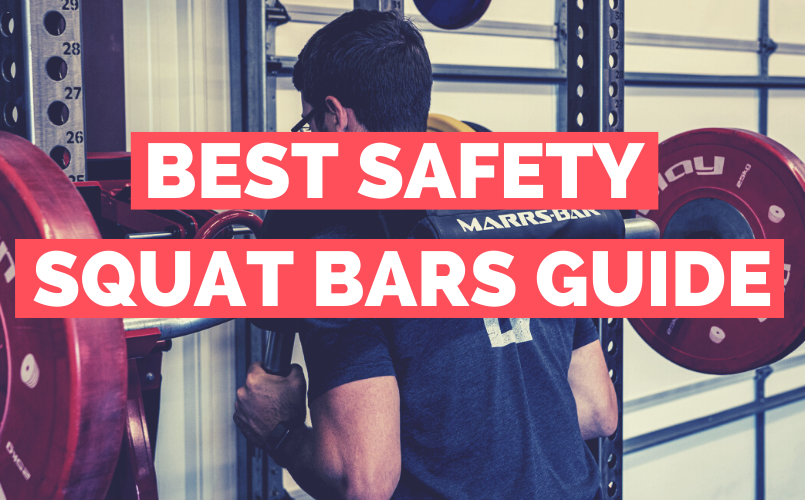- Safety squat bars—or SSBs for short, are specialized bars that make it both easier and more comfortable to perform weighted squat workouts despite upper-body injuries.
- If you’re in the market for the best Olympic squat bar for the money, the Rogue Fitness SB-1 is your only choice.
- On the other hand, if you’re looking for truly heavy-duty use options, the PerformBetter and Adder Sports Safety SSBs are worth looking into.
7 Best Safety Squat Bar Models (List for 2024)
1
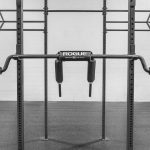
Rogue Fitness SB-1
- The Cerakote finish is low-maintenance and visibly stunning
- The barbell weighs 70lbs unloaded
- Rogue is well-known for its quality customer service and reliable line of products
2
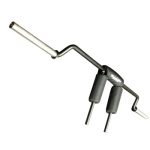
Vulcan Strength
- The padding and handles are covered by a 90-day warranty
- The barbell and the sleeves are covered in a three-year warranty
3
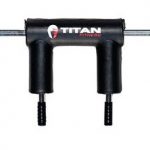
Titan Fitness
- It costs under $230, which is cheap for a heavy duty barbell
- The 5-inch camber drop helps with stability
4
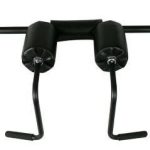
American Barbell
- American Barbell is a reliable brand that is known for its quality equipment
- The barbell’s powder coating looks sleek
5
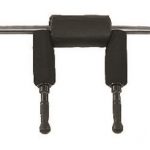
Perform Better
- The padding is comfortable and not overstuffed
- It feels quite similar to a standard Oly because of its 7 foot length
6
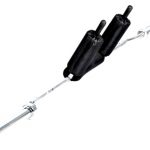
Xtreme Monkey
- It’s affordable
- It’s made of durable, heavy-duty, high-tensile-strength solid steel
7
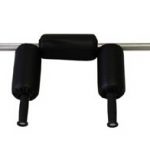
Ader
- It is shipped quickly and is packaged with the utmost care
- The pads can hold up to years of daily use and only show minimal signs of wear
Back when I was just starting out, we didn’t have how-to guides on choosing the best equipment. You had to go by your gut, personal experience, the advice of your gym buds, and maybe hire a professional trainer to tell you what to do. I didn’t have enough money to hire a professional so I had to go around buying several different types of bars.
Fortunately for you, the internet is a more accessible resource so you have access to experts, myself included :), who are eager to share their favorite safety squat bars to save you the trouble of poring through countless infomercials.
1. Rogue Fitness SB-1 - #1 Choice
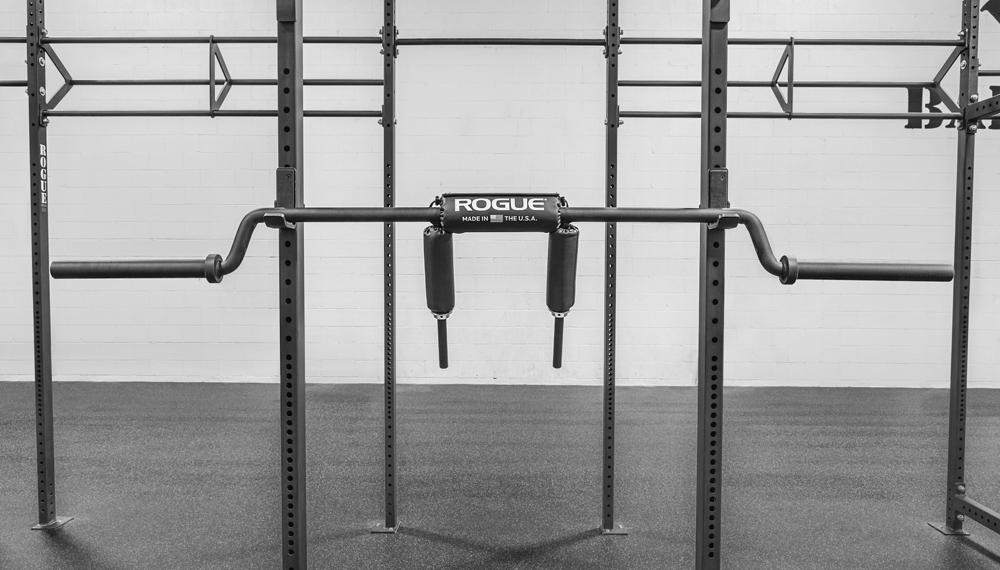
The Rogue Fitness SB-1 sports a classic SSB look with a premium Cerakote finish that works well in non-regulated temperatures. It’s backed by Rogue’s signature craftsmanship and is built using durable steel, reinforced welding, and premium precision engineering. This only means your home gym barbell is unlikely to rust, requires constant maintenance, and will last you a very long time.
Here are its best qualities:
Cerakote Coating – the Cerakote finish is arguably one of the best finish options in the market. However, many lifters tend to overlook it simply because they can get expensive. For home gym use, this finishing gives your bar a beautiful feel as well as resists oxidation and general wear and tear, so your bar will last longer with little effort.
Heavy Duty Padding – we’ve talked about the importance of padding before, and the SB-1 does not disappoint. The stitching is heavy-duty and will last against daily use. You’ll also notice that the padded bar holding system wears well, so you don’t have to worry about reinforcing it with duct tape after a few months.
PROS
- Premium craftsmanship with precisely engineered parts and clean welded parts
- Rogue is well-known for its quality customer service and reliable line of products
- The barbell weighs 70lbs unloaded, which means it can handle heavier loads
- The pads are well-designed and durable, so you know they will last you a long time
- The Cerakote finish is low-maintenance and visibly stunning
CONS
- Some would consider it a bit expensive even though it costs under $400
Summary: The SB-1 SSB is an ideal choice for you if you’re looking for a heavy-duty safety bar that will last you for a long time. Its Cerakote finish combined with the high-quality craftsmanship Rogue is known for means it will look new years down the road even if you use it on a daily basis. Unfortunately, it costs over $300, which some might consider too expensive for a home gym bar.

.
2. Vulcan Strength - Runner Up
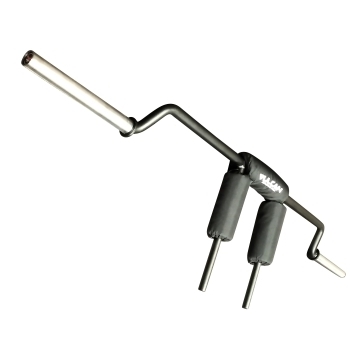
The Vulcan Safety Squat Bar features a sleek, no-nonsense design that is reminiscent of traditional safety bars.
Its black powder coat finish guarantees that it won’t rust even if it’s exposed to sweat and oxidation frequently or if you neglect to wipe it down after each workout.
Priced at under $300, this SSB will last you a long time and will easily become a favorite in your house gym.
Here’s why you’ll like it:
Vinyl Padding – the vinyl pads are reinforced with premium stitching and are adequately padded to provide both support and comfort during your workouts. Warranty Coverage – your safety barbell and sleeves will be covered with a three-year warranty while the padding and handles are covered for 90 days.
PROS
- The black powder coat looks beautiful, and at the same time, it also protects your bar against rusting
- The vinyl padding is durable and will last for many workout sessions without showing any signs of wear
- The barbell and the sleeves are covered in a three-year warranty
- The padding and handles are covered by a 90-day warranty
CONS
- It only weighs 24kgs, so it might not be suitable for you if you’re a powerlifter who wants to be able to lift heavier loads. However, it’s definitely enough for intermediate and beginner lifters
- The powder coat will eventually wear off
- The handles are non knurled
Summary: If you’re looking for an affordable, well-built, and classic-looking squat bar with no added features that could drive up the price, the Vulcan Strength Safety Squat Bar is something you should look into. It costs a little under $250 which makes it a good cost-effective option for beginners and intermediate trainers who want a basic SSB for their home gym.

.
3. Titan Fitness Safety Squat Olympic Bar v2 - Best Economy Option for Beginners

It has a unique “bend” feature combined with the 5-inch camber drop that shifts your center of gravity for a more ergonomic workout and better stability. It costs under $230 and can handle weights up to 1,500 lbs, which means there’s plenty of room to grow into the bar if you’re just a beginner. The padded shoulder and arm pads increase your comfort level at higher weights.
Here’s why you’ll like it:
Unique Bend – what most unsuspecting trainers often mistake for flex brought on by bad construction is actually a bending feature engineered into the bar. The barbell bends slightly when you add weights to adjust your center of gravity, making it more comfortable to bear heavy loads.
Six Inch Hand Grips – the hand grips on this squat bar make it so you can easily have something to hold onto for balance. The length is ideal if you want to keep your wrists relaxed and keep better control over your workout.
PROS
- The 5-inch camber drop helps with stability
- The 22-degree handle angle is comfortable and keeps your hands in a neutral position
- The product weighs 61 lbs and is durably built
- It costs under $230, which is cheap for a heavy duty barbell
- It can lift up to 1,500 lbs
CONS
- The bending feature is unnecessary and seems like a gimmick from the company to get away with faulty bar design
Summary: It is an ideal choice if you’re looking for a good heavy-duty bar that has a bit more flex to it. While I agree that the ben feature did throw me off, you might benefit from the gravity shift and end up enjoying it instead. Otherwise, I don’t see the point in adding the bend to a squat safety bar.

.
4. American Barbell SSB

American Barbell has always had a spot close to my heart. It’s one of the first barbell brands I invested in, and back then, it didn’t disappoint. I could say the same for their SSB. It features a 15.5-inch loadable sleeve length and heavy-duty build that can outlast extensive workouts, sweat, and heavy weights. It’s priced at just shy of $400, so it’s a bit on the expensive side, but still a good investment for beginners or intermediate lifters.
Take a look at its best qualities:
Powder Coated – the American Barbell Safety Black Oxide is powder-coated to ensure longevity and so you don’t have to worry about daily, weekly, and monthly maintenance to keep your bar free from rust and patina.
Made in the USA – it’s called American Barbell for a reason. Not only are their SSBs durable and well-built, but they’re also made in the US, so it’s easy to contact customer service. Plus, you know that they’re held to a high standard.
PROS
- The barbell’s powder coating looks sleek, gives the bar a matte look, and protects well against oxidation and unregulated temperatures
- The loadable sleeve length is 15.5 inches, which means you can load more bumper plates on it, and it can handle heavier loads
- American Barbell is a reliable brand that is known for its quality equipment
CONS
- You could say that it’s a bit overpriced since it costs nearly $400 and is pretty basic
Summary: The American Barbell SSB is a good choice if you want a solidly built standard squat bar. However, for nearly $400, the Rogue Fitness SB-1 would be a more cost-effective choice.
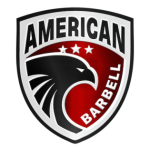
.
5. PerformBetter SSB - Best for Heavy Squats

The PerformBetter SSB is designed to power through heavy squatting. It’s 7 feet long and weighs 65 lbs unloaded, so you know it has a high maximum weight capacity.
The total length of the bar also contributes to it feeling more like a standard Oly, which is great if you’re also adamant about powerlifting and want to find a way to incorporate ergonomic squats into your routine.
Here’s why you’ll like it:
Thick, Solid Steel – the bar itself is made of 11/8-inch solid steel that weighs 65 lbs. It’s designed to lift up to 1,000 lbs without flinching and is guaranteed to put up well against constant use.
Durable Padding – the padded section of the bar is adequately padded, so it isn’t too soft nor is it too hard. Not only does it allow you to feel more comfortable, but it also directly allows you to power through more intense workouts.
PROS
- It’s made of durable, high-grade 11/8 inch solid steel
- It can handle up to 1,000 lbs of weight
- It feels quite similar to a standard Oly because of its 7 foot length
- The padding is comfortable and not overstuffed
- The handles are adequately knurled for comfort and added grip
CONS
- It’s a bit expensive—it costs a little under $350
Summary: The PerformBetter safety barbell makes it possible for you to perform heavy, highly demanding squats better. It basically allows you to combine the demanding components of weight lifting with squats so you’re more comfortable, but are still able to push through the amount of weight you’re used to lifting. Unfortunately, quality costs extra and this model, in particular, will cost you nearly $350.

.
6. Xtreme Monkey XM-3490 - Best Budget
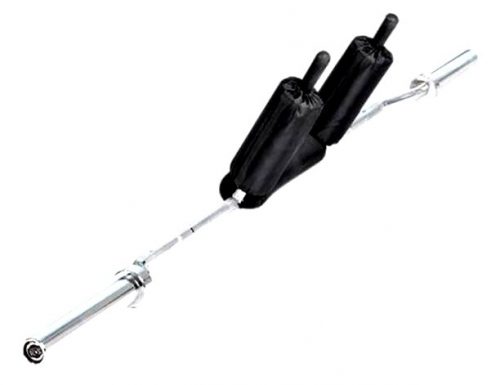
The Xtreme Monkey XM-3490 boasts a heavy-duty construction and weighs 50 lbs unloaded.
It can lift upwards of 1,000 lbs—presumably, and all of this for under $250. It’s a good starter barbell if you’re looking for an affordable bar that can adapt to your strength growing in the future.
Here’s what you’ll like about it:
Heavy Duty Solid Steel – the bar itself is made of 30mm high tensile solid steel that is resistant to warping and bending. This means your bar will not only be able to take heavy loads over 1,000 lbs, but that it will also last you a very long time if given the proper care.
Affordable Price – just shy of $250, this bar is available in Walmart stores across the US and is a good investment for both beginners and intermediate lifters alike.
PROS
- It’s affordable and costs a little over $240
- It can handle over 1,000 lbs of weight
- It’s made of durable, heavy-duty, high-tensile-strength solid steel
CONS
- The silver finish will need some maintenance if you want to keep it looking new
Summary: The XM-3940 can be purchased in Walmart stores across America. Its high-tensile strength steel build makes it ideal if you want an affordable, heavy-duty bar that will last you a very long time in your gym. Unfortunately, it will require some maintenance if you don’t want it to rust.

.
7. Ader Safety Squat Olympic Bar 1000LB, 1500LB - Best Heavy Duty

The Ader Safety Squat Oly Barbell is a heavy-duty bar that can withstand either 1,000 lbs or 1,500 lbs of weight.
It’s rackable and built using heavy-duty solid steel that won’t warp or become brittle over time, so there’s virtually nothing to worry about unless the company doesn’t ship to you.
Take a look at its best features:
85 Lbs Unloaded – The bar itself is heavy in its own right. That only attests to the fact that it can lift as much as it says it will. This 85-lb ssb can handle up to 1,000 lbs without flinching and even comes in a variety that is designed to withstand 1,500 lbs of Olympic weights.
Padded Shoulders – the padding consists of foam rollers covered in well-stitched vinyl. The quality is good and looks like it will put up against consistent use.
This also means you don’t have to worry about covering it in duct tape anytime soon.
PROS
- The pads can hold up to years of daily use and only show minimal signs of wear
- It is shipped quickly and is packaged with the utmost care
- It can handle either up to 1,000 lbs or 1,500 lbs of Oly plates
CONS
- It is quite expensive and costs over $400
Summary: The Ader SSB is arguably the most heavy-duty bar on this list. But it’s also the most expensive. However, I recommend it if you’re looking for a bar that is truly an investment and will last you a very long time instead of just a few sweet years of daily training.

.
What Should You Look for in a Safety Squat Bar?
Much like choosing any piece of equipment for your home gym, it’s important that you take a good, long look at your prospective barbell before making a commitment.
Some users don’t know this, but overlooking the smallest thing—like the finish, could leave you regretful of your purchase. There are four things you should consider before buying a safety squat bar: camber measurement, padding, steel quality, and handles.
Camber Measurement
To get the right camber measurement, you’ll have to specifically ask the distributor or shop in physical stores. Unfortunately, it can be difficult to find the camber details on product pages. In most cases, it’s even non-existent.
While most camber on squat safety bars is pretty standard size, there are some that are longer. This could be an issue since the camber length directly affects how much the bar throws you forward.
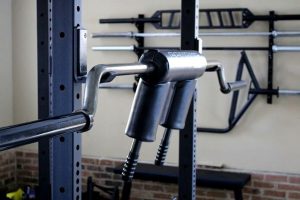 Standard-sized cambers are usually non-noticeable and won’t affect your performance much.
Standard-sized cambers are usually non-noticeable and won’t affect your performance much.
However, if you’re more finicky, I recommend testing out a few models and determining the right camber offset for yourself.
Padding
The padding might seem unnecessary, but it’s one of the key features of safety squat bars. Make sure you choose equipment that has enough padding that would last a long time. Many trainers seem to think it looks better to have your padding covered in duct tape to make it look more “manly” but it’s actually counterproductive and a waste of an otherwise expensive piece of outfit.
Steel Quality
Like any barbell, it’s important to make sure you’re getting a durable piece of equipment since it’s going to lift several heavy weights. You don’t want your bar warping—or worse, breaking while you use it just because low-quality steel was used.
Make sure your bar is thicker than a straight bar, and it should weigh over 65 lbs if you want a truly heavy-duty unit.
Handles
Last but not least, you should consider your handle design. Look into the knurling pattern as well as the length of a bar’s handles. There are some SSBs that have shorter handles, while there are some that have handles that can reach up to your knees.
You have to remember that this would depend entirely on your preferences. However, longer handles might make you feel a bit restricted when you’re performing front squats.
Why Should You Use a Safety Squat Bar?
Much like any specialty barbell, squat safety bars make it easier to perform certain activities. In this case, it’s squats. This makes it ideal for you if you’re looking for a way to perform more ergonomic squat-type movements and if you’ve been having trouble doing those on a traditional straight bar.
To Reduce Upper Body Stress
Safety squat bars put your upper body in a more neutral position. This means your shoulders, traps, arms, and wrists are all less strained while you perform squats. Their unique design makes it seem like your upper body is resting during your movements and allows you to focus on holding your position, reaching the optimal depth, and even power through injuries you may have in your upper body.
To Strengthen Your Upper Back Muscles
One of the reasons why I prefer squat safety bars over standard straight barbells is because it helps strengthen your upper back muscles.
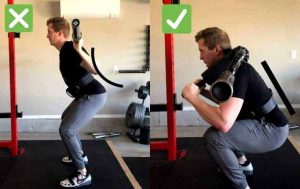 Because your shoulders are in a lax position, your upper back is working twice as hard to support your position and the weight of your SSB. It’s also ideal if you want to improve your posture or if you just want to work on your upper back muscles for the heck of it.
Because your shoulders are in a lax position, your upper back is working twice as hard to support your position and the weight of your SSB. It’s also ideal if you want to improve your posture or if you just want to work on your upper back muscles for the heck of it.
Another benefit of strengthening your upper back muscles is that it helps you perform more precise straight barbell squats.
So if you’re having trouble holding your posture, working on your upper back using squat safety bars is something you should do.
Better Versatility and Exercise Variety
Like any other specialized barbell, an SSB will help you perform a variety of equipment-specific workouts. Take, for example, the yolk walk. You’re not able to perform yolk walks on standard straight bars. Sure, you might have seen some trainers attempt to do this or execute it, but the risk of your barbell rolling off your back is too huge to even consider.
You’ll also be able to perform certain squat variations that would otherwise be too difficult or impossible on standard bars like the Hadfield squat. This makes SSBs ideal if you like to focus on squat-type exercises more than powerlifting.
Frequently Asked Questions About Safety Squat Bars
I remember when I was younger and didn’t know much about specialized bars. I wanted to get my hands on every single type of bar there was. I wish I had someone to ask about the more technical things though, back then, you had to rely on other gym buffs who were only speaking from experience‚—which wasn’t much at all.
That’s why I try my best to answer every question my clients may have about all types of outfit. Below, I answer some of the questions I frequently encounter regarding safety squat bars.
Is a Safety Squat Bar Worth It?
Absolutely, a Safety Squat Bar (SSB) holds significant value in the realm of strength training and weightlifting. This specialized barbell variant offers distinct advantages that make it a worthwhile investment for individuals seeking to enhance their squatting regimen.
The key benefit of a Safety Squat Bar lies in its ergonomic design, featuring padded shoulder and neck rests, along with handles in front. This design minimizes strain on the shoulders, wrists, and elbows, making it especially beneficial for athletes with mobility limitations or discomfort in these areas. The SSB promotes a more upright torso position during squats, which shifts the emphasis to the quadriceps and reduces excessive stress on the lower back. Scientifically, this altered biomechanics can mitigate the risk of lumbar strain and promote safer squatting mechanics.
Furthermore, the Safety Squat Bar challenges stability due to its unconventional load distribution. This prompts increased core engagement and strengthens stabilizer muscles. Scientific studies have shown that such dynamic resistance variations can enhance muscle activation and contribute to functional strength gains.
Incorporating the into training also offers versatility. It can be utilized for a variety of squat variations, lunges, and even as a tool for accommodating resistance during other exercises.
In summary, it presents a scientifically supported advantage by reducing stress on joints, promoting optimal squat mechanics, and fostering balanced muscle development. Its potential to enhance stability and accommodate various exercises further underscores its value. Therefore, for those seeking a comprehensive and effective approach to lower body strength training, investing in a Safety Squat Bar is indeed a prudent decision.
Is it Harder to Squat With a Safety Bar?
When it comes to squatting, the choice of barbell can significantly impact the difficulty and mechanics of the exercise. One popular variant is the safety bar squat, which uses a specialized bar with padded shoulders and hand grips that extend forward. This unique design prompts the question: is it harder to squat with a safety bar compared to a traditional straight barbell? Let’s delve into the specifics.
Biomechanical Differences
The safety bar squat differs biomechanically from the traditional back squat. The safety bar’s cambered design shifts the center of mass slightly forward. This anterior displacement changes the load distribution, requiring greater engagement of the quadriceps and upper back muscles to maintain an upright torso and stabilize the bar. The forward shift also reduces the shear stress on the lower back, potentially lowering the risk of injury but demanding more from the upper body and core.
Muscle Activation and Stability
Research indicates that safety bar squats can lead to increased activation of the quadriceps and upper back muscles compared to traditional barbell squats. A study published in the Journal of Strength and Conditioning Research found that lifters using a safety bar showed higher electromyographic (EMG) activity in the upper trapezius and quadriceps. This increased muscle activation can make the exercise feel more challenging, especially for individuals with weaker upper backs or less quad dominance.
Postural Considerations
The design of the safety bar encourages a more upright posture. For lifters with limited shoulder mobility or those prone to forward lean during traditional squats, the safety bar can be particularly beneficial. However, maintaining an upright position with the safety bar can be harder for those with less developed upper back strength, potentially making the exercise more taxing.
The safety bar’s padded shoulders and forward grips offer greater comfort and stability, reducing strain on the wrists and shoulders. This ergonomic advantage can make squatting less intimidating and more accessible, especially for individuals with shoulder or wrist issues. However, the increased demand on the upper back and core for stabilization can present a greater challenge, contributing to the perception that safety bar squats are harder.
In conclusion, squatting with a safety bar can indeed be harder due to the altered load distribution and increased muscle activation required for stabilization. While it provides ergonomic benefits and reduces lower back strain, the demand on the upper back and quadriceps can make the exercise more challenging for some lifters. As with any variation, the specific difficulty will depend on an individual’s strengths, weaknesses, and overall conditioning.
Yes, it’s easier to squat using a safety bar. The way safety bars are designed them ideal if you’re having difficulty squatting using a straight bar. Safety bars reduce strain on your shoulders, wrists and trap muscles. They also put you in a squatting position that is reminiscent of sitting down instead of sitting back, which means you’re better able to hit an optimal depth even with weights.
Jesse Hoagland manufactured the first safety squat bars for 29 years through his company—Natural Power Safety and Fitness. The former factory steel worker was known to bend each bar by hand before distributing it to his customers.
A standard safety squat bar will weigh anywhere between 20 and 32 kilograms. The weight variation will determine exactly how sturdy your barbell is, and it will also let you know how much weight it can handle. Generally, the heavier your bar is, the more weight it can take.
Safety squat bars make it easier to perform front squats. The SSB was created specifically to help you execute weighted squats more ergonomically. It’s particularly ideal for front squats, too, since it removes any issues or concerns with mobility and grip.
Squat bars weigh 44 lbs on average. Some people may think that this means it can handle just about as much weight as a standard barbell can since they have the same unloaded weight. However, squat barbells are designed to carry more weight.
Exercises You Can Do With a Safety Squat Bar
What many newbies don’t know is that there is a multitude of squat variations you can do. There’s more to squats than the typical sumo squat you see most gym-goers execute. And despite what the name suggests, it’s not just for squat sessions, although that is what it’s primarily made for.
Box Squats
Box squats utilize more than just your body and your SSB. You need a box behind you that you can sit on. Ideally, it should be just the right height so you can still hit the right squat depth when you perform the workout.
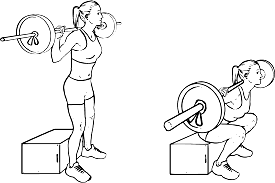
It’s done by sitting on the box, then suddenly standing/pushing off of the box. This workout is good for working on your explosive strength.
Good Mornings
Good mornings allow you to strengthen your core strength and anterior chain. To perform this workout, you have to place the bar on your back and bend your torso forward slowly then bend upwards while maintaining a tight core.
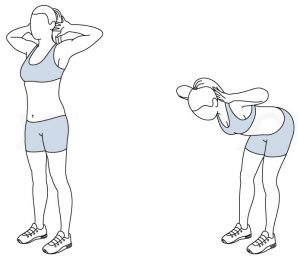
This movement can also be performed using a straight bar. However, it is incredibly difficult and complicated to do so.
Walking Lunges
Walking lunges help you improve the strength of your squats. While most could argue that this exercise can be performed on standard bars too, SSBs remove the need to worry about grip strength. Instead, you’re able to focus on the targeted muscle groups.
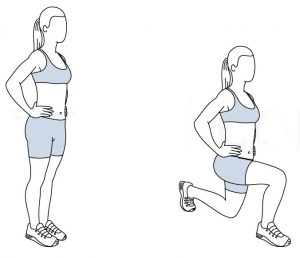
To execute this workout, you need to place the padded portion on your shoulders, take hold of the grips, and proceed to make your lunges.
Low Bar Squats
Not many trainers are familiar with low bar squats. This squat variation targets your glutes and legs by forcing your hips backward and your chest forward. It also lets you push more weight while maintaining proper form. To perform this exercise, you need to place the bar between your rear deltoids then process to perform your squats.
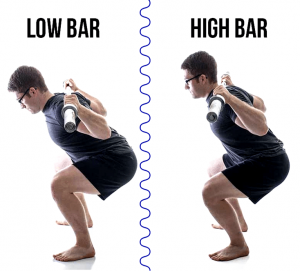
You can perform this workout on a straight bar. However, you may find it difficult to do so, especially if you’re just starting out. A squat safety bar will help you perform it more easily and with less complications.
Can You Squat More With a Safety Bar?
Our body weight certainly determines the amount of pressure your feet have on the bar. But what if you could increase the pressure you feel on the bar because of how you’re holding the bar? That’s a bit of a different ballgame. The concepts are similar, but it all comes down to specific sets, rep schemes and mechanics, and how you perform them. Let’s take the safety squat bar as an example. A big group of people has the tendency to squat on the straight bar, which is a true barbell squat. It forces them to use their thighs and core. However, if you are going to use a safety squat bar, it means you’re going to be leaning forward onto your toes, and be on your heels. That’s what’s known as a deep squat. If you’re squatting like that, you are going to be putting a lot of pressure on your knees and your lower back. This is a terrible squat for many reasons. One of the main reasons is that you will have your spine bent in a very unnatural fashion, which is going to put a lot of tension on your neck and neck muscles. You will also likely lose a lot of height. You might squat 150-170lbs if you’re using a safety squat bar with safety squat bar shoes. But if you were using a regular barbell squat and properly bracing your torso, you’d probably be squatting closer to 190lbs.How to Use Safety Squat Bar?
Using a barbell or dumbbell can be an effective exercise, but this safety squat bar is a new twist on a common exercise and does not require the equipment used in regular squat racks. These bars are more than a squat rack accessory, they can be used for basic, bodyweight exercise, while still providing a full range of motion. This squat bar is specifically designed to be adjustable, can be placed under different foot types, and has a good tension level. Because the safety squat bar is positioned at a 90-degree angle and the elevated handle increases the strong demand, it can be used as a workout for isolation muscles, with proper form. This portable safety squat bar will be a good workout for anyone looking for a safe workout without the risk of injury..Which Bar is Best for Squatting?
There are essentially four basic barbell squat styles. The Squat is typically performed with a stout barbell from about chest-height, although 5′-8″ is a common starting point. Some prefer the bar to be racked above the knees or in a neutral position, where it can be used for any movement. The bench press may be used as a benchmark in judging the style. It is also interesting to note that the gluteus maximus is trained with a barbell. If your back muscles are overdeveloped, then you will probably be able to squat better with a barbell than you can with a dumbbell. To demonstrate the differences in barbell squatting, here are the four standard barbell squat styles. There’s no doubt that squatting is one of the most powerful exercises you can perform. Though there are other powerful squats like the deadlift, clean and jerk, or bench press that push your body beyond its natural capabilities, none of these lift your total poundage and are judged more often than the squat.Is Safety Bar Squat Easier?
The term “safety squat” is used by many as an easier way to squat. I’ve encountered many people who say that “No, it is not.” So what are they talking about? First, here’s some background. When I was in high school I joined a gym and joined the men’s division of weightlifting. On one of my first days, I saw a squat rack that was put together like a barbell squat rack: a flat bar, a bar running to the top. I was intrigued. I went home and looked up “regular” squat racks and found that the bar ran from the bottom of the squat rack to the top, sort of like a bell. I called the gym and asked for the details, and was told that it was the new standard in squat racks. That intrigued me even more. So now you know. But some people are using the term “safety squat” to mean that a regular, bell-shaped squat rack is somehow “less effective” or “not safe”.Final Words. What is the Best Safety Squat Bar?
If you’re looking for a reliable, well-built bar that will last you for a very long time without requiring daily, weekly or monthly maintenance at all, the Rogue SB-1 should be the first bar you look for.
Its Cerakote finish not only looks sleek and professional, but it also protects well against harsh elements.
On the other hand, if you’re not willing to spend over $300 on an SSB, the XM-3490 is a good budget option that is still reliable and will last you a very long time.
For under $250, you’re investing in a safety Oly bar that can lift up to 1,000 lbs with ease.
